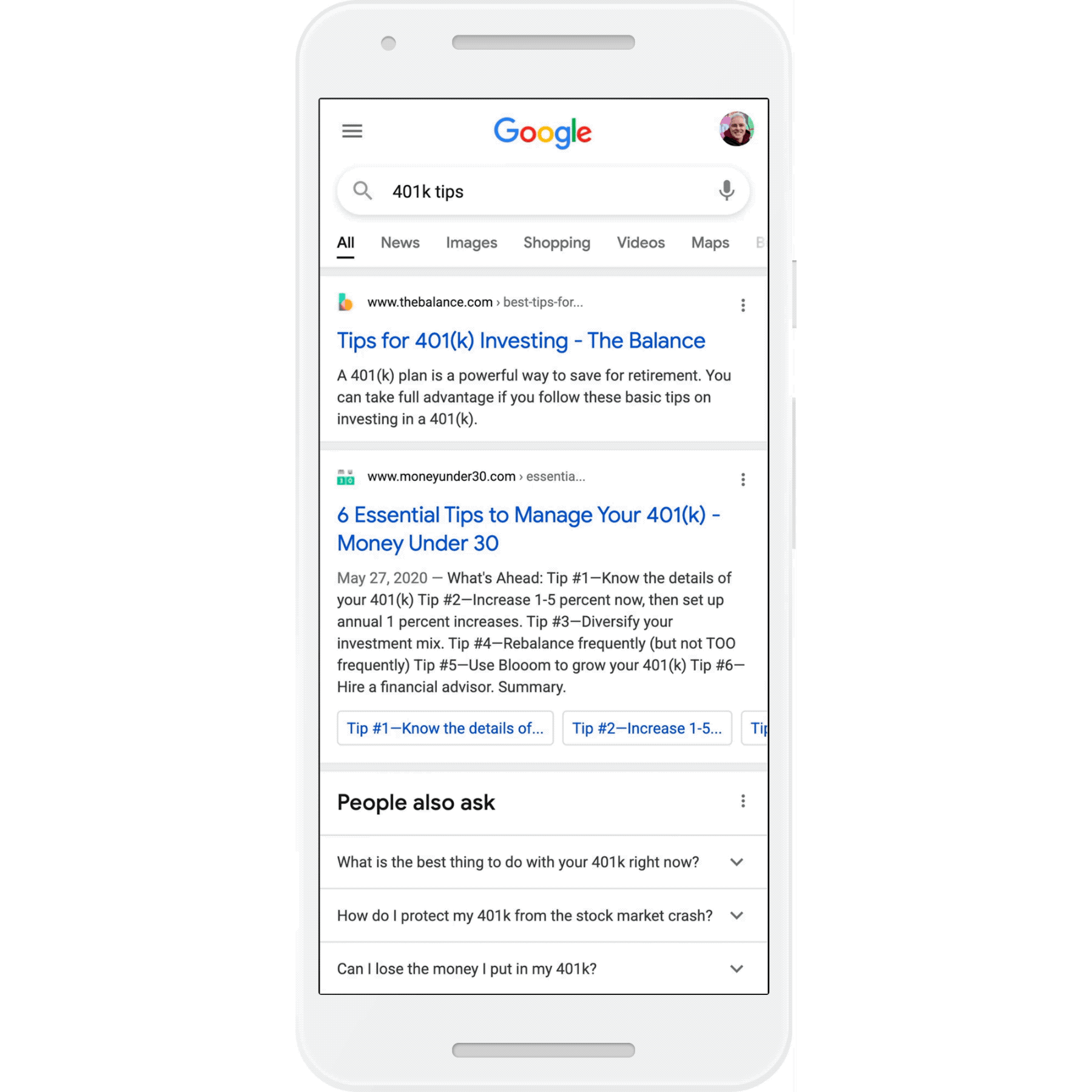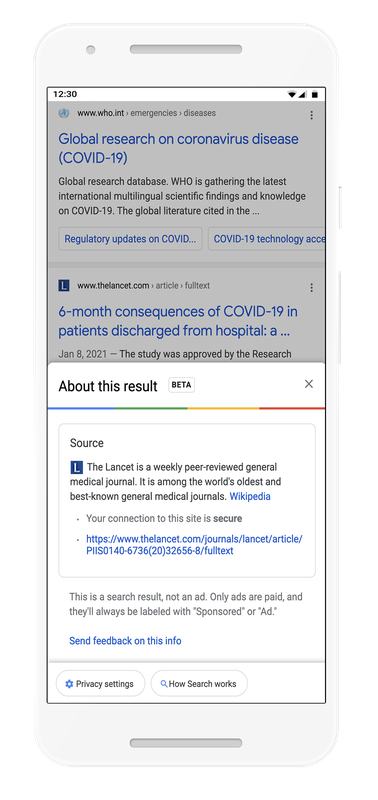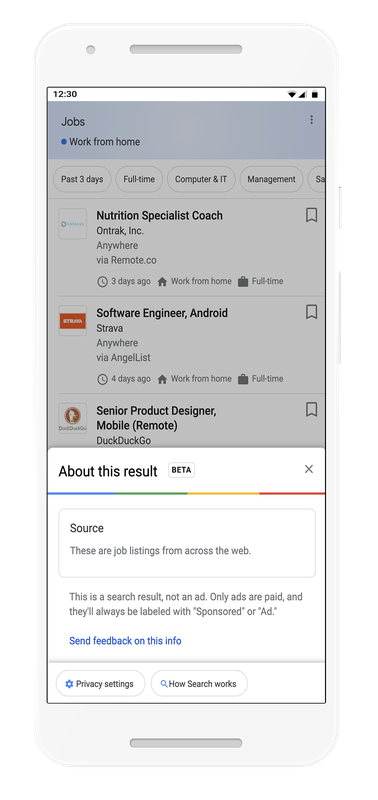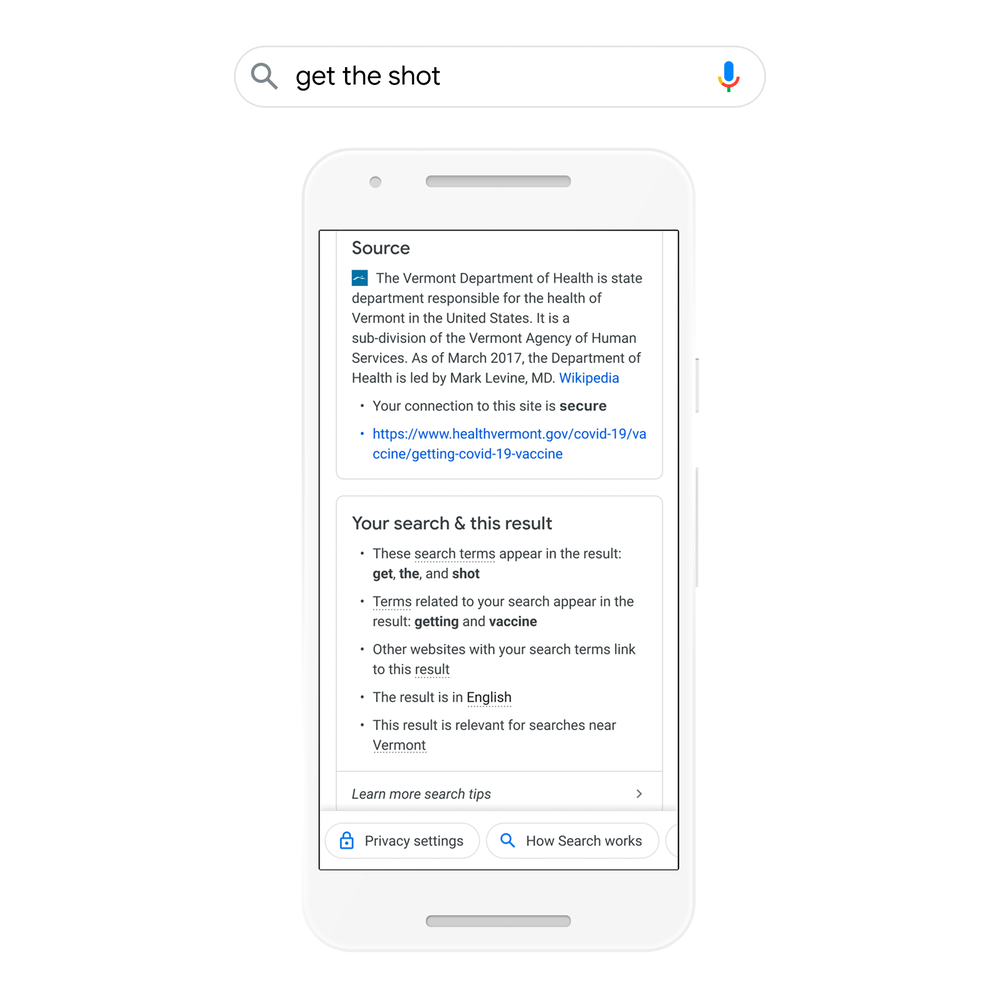About this result, the feature with information about sites in SERP
It debuted for English-language searches on Google U.S. desktop, mobile, and Android apps in February 2021, and almost two years later it has arrived here: we are talking about the About This Result feature, which as of October 26, 2022 is available for people searching in Portuguese, French, Dutch, German, Spanish, and precisely Italian in Europe. Its function is quite simple: by clicking on the three dots that appear next to each result placed in Google’s SERPs, search engine users display a widget that provides key information at a glance useful to better understand the website they intend to click on and get some more details about its reliability.
Google’s new feature to discover info on sites
This particular search results snippet is activated by clicking on the three vertical dots that appear to the right of the URL of the site placed: at this point, a new box opens that offers more information “about this result” (literary translation of the name of the function), which presents verified and updated news on the site, recovered from Wikipedia, and also indicates whether the connection is secure, whether it is an organic or paid ad and other details.
Specifically, this new tab with additional information on the result allows you to read:
- A brief description of the domain from Wikipedia (when available).
- Use of the HTTPS protocol on the domain as a security feature.
- Full URL of the search result.
- Note on the type of result (if it is organic or an advertisement).
In addition, the tabs give users quick access to their privacy settings and a link to a video on how search works.
As explained by Nidhi Hebbar, Product Manager at Google, with a click “On this result” the user can:
- View more information about the source, namely a description of the source from Wikipedia (where available) but also “what a site says about itself in its own words” and when it was first indexed by Google.
- Find what others on the Web have said about a site through news stories, reviews, and other useful background context for support in better evaluating sources.
- Read more about the topic in the “About Topic” section, which shows additional items such as major news stories or results on the same topic from other sources.
What the feature is for
So it is quite understandable what the purpose of About this result is, which, in the U.S. company’s goals, should help users know more about the search result or search feature they are viewing and are interested in clicking on, without having to visit the site directly or having to launch another search to get this news.
As JK Kearns, Search Product Manager, writes, this feature can help “give context or tranquility, especially if the user is looking for something important, such as health or finance information”, especially if the result positioned is “a site you’ve never heard of”.
When looking for information on Google, in fact, “you probably often come across results from sources you know: large e-commerce sites, national newspapers and more”, but “there are also plenty of great information and services available from sites you may not have encountered before“. Knowing in advance the identity card of the site placed on Google could serve people to understand if that result is a reliable source of information and if it is relevant to their intentions.
Info from Wikipedia (and not only)
The most original aspect of this feature is the description of the site taken from Wikipedia, “which provides free and reliable information about tens of millions of sites on the web” and “is based on an open editing model and the work of thousands of global volunteers to add content,” Kearns recalls.
This additional tab will provide the most up-to-date and verified information available on Wikipedia on the site that Google has classified in SERP. The choice to depend on the famous encyclopedia somewhat levels the playing field, but inevitably excludes many smaller sites that do not have their own entries.
However, if a site does not have a page/description on Wikipedia, Google will still show some data to users, and to be precise “an additional context that might be available, for example the first time that Google indexed the site“.
For some special features provided by Google to organize different types of information – and in particular job listings or local business – users will see a description “how Google acquires this information from websites on the Web or from companies themselves and presents it in a useful format”.
The evolution of About This Result
The European version of About This Result already features some of the new features implemented in the U.S. trial, and in particular this small tab also reports a number of reasons why Google chose to place the examined page in SERPs.
This big and interesting new feature was announced in July 2021 on The Keyword blog by Elizabeth Tucker, Google’s product manager, and is intended to make it easier for users to evaluate which page might be most useful and relevant to their intent by providing them, as a sign of trustworthiness, with a transparent overview of the reasoning that convinced Google to place that result.
Google reveals the SEO reasons for ranking a result
While it may be interesting for regular searchers to discover this information, the feature has quite different value for SEOs: for the first time, in fact, Google gives a rationale as to what ranking factors were considered and used to make that particular page stand out for that particular query.
In more detail, as also seen in the examples on the page, for ranking Google considers these factors, analyzed by Search Engine Land:
- Search terms appearing in the result
The web page contains the same keywords as the search, and the algorithm has identified this matching between the words used in the searcher’s query and the keywords present in the page content. These matches may be present not only in the visible content, but also in the HTML, particularly in the title tags or other metadata.
- Search terms related to the search query
The content intercepted the query with related terms: in the graphic example, the query was [shot] but Google expanded it to include the meaning “vaccine”. In short, Google does not only search and reward the exact match, and if you search for “how to cook fish in the oven”, we will also find pages with related terms such as “bake” and “recipe.”
- Other websites with the user’s search terms link to this result
The algorithm recognizes that sites that have the query’s search terms in their pages and links actually link to the result listed in Google’s search results. The presence of backlinks can also be “a useful indicator that other online content creators tend to consider the page useful for that topic.” In other words, it is confirmed that links are still used by Google for ranking purposes.
- Result contains images related to search
Google also examines the images on the page to determine whether, through data such as the filename of the resource, they are actually related to the content and related to the user’s query.
- This result is in [language]
Language is important: Although the feature is currently only in English, Google will also report on other languages in the future. Quite simply, if the query is in Spanish, Google is more likely to show Spanish results.
- This result is relevant for searches in [geographic area].
Geolocation is also becoming increasingly important-Google evaluates the user’s location, the location of the site, and the query to determine whether the searcher wants to find a web page most relevant to a specific region. Again in the example, a person searching Vermont for [get a vaccine] probably wants to get local Web sites with information about vaccines in Vermont; or, if we search “what is trash pickup day?” it is useful to get results applicable to our city or country. Sometimes the queries may be at the city level and sometimes the region is not relevant, and Google will show all these details in this window.
Making more sense of context, information and results in SERP
This feature, Mountain View explain, is “a quick and easy way to see useful context about how Google returned results for your query and to find functional suggestions for getting more out of Google Search.”
When we search for information on Google, we’re probably used to seeing so many relevant results in a split second, and “maybe you’ve wondered how Google linked those results to the words you typed, especially if you didn’t get exactly what you expected to find.”
The About This Result panel (accessible by clicking on the three dots next to most results) is for just that, and with today’s expansion it will show “even more information about your results to help you make sense of the information and figure out which result will be most useful.”
With the vast amount of information available on the Web, the article continues, it would be nearly impossible to find what we need without help in sorting it: Google’s search systems are designed to do just that, which is to “sort through hundreds of billions of web pages to find the most relevant and reliable results and present them in a useful way.”
We know that the way Google determines what information is relevant and reliable for a given query is based on many different factors: although it is a complex operation, “some of these basic concepts are actually quite simple and can be useful for people to understand when they start searching.”
About This Result shows users precisely information about some of these “most important factors” used by Google Search to link results to their queries: just as these signals help Google decide whether a result is likely to be relevant, they can also help people decide which result is useful to them, the author argues.
New Search tips
The enriched panel is designed to serve another function as well, namely “highlighting useful search suggestions to help Google better understand what you’re trying to find,” so as to make it easier to refine your search in cases where “the results you see in Search aren’t quite what you’re looking for.”
Specifically, About This Result will show search techniques or settings that we can use to modify the search to get the results we want.
For example, if we usually search in English, but want to find results in a different language or from a different region, the feature makes it even easier to adjust the settings.
Or, it helps us modify our search: for example, if we search for “best jogging shoes,” Google might usually return results on related concepts, such as “running shoes,” but this way we have the opportunity to focus our search only on results related to shoes optimized for jogging.
In addition, this panel shows us tips on how to get what we really wanted by suggesting the use of advanced search operators: for example, we can put a word or phrase in quotes to get results that return exactly those words, or use a minus sign to exclude certain words from the search.
In the example shown by Google, the user can place the mouse cursor over the underlined words in the box to get search suggestions on how to better narrow the search results. In particular, Google suggests that the search could be more precise by adding a minus sign next to a word to filter it out and exclude it from the search.
More context for searches
In addition to providing information about the origin of the content and the security of the connection to the website, About This Result contains and presents a large amount of data about relevance signals.
This tool thus stands as another useful way to get more context on the results we see in Search, along with other features recently introduced by Google, such as the alert that appears when the search engine deems results to be not particularly relevant or for those that are rapidly changing: all of which combine to help users find what they are looking for and be better equipped to evaluate the information they find.
What this feature means to sites
The feature is designed purely to improve the experience of users, who have the ability to quickly make more informed decisions about the site they are about to click on, and it is the result of a long implementation work: as mentioned, it debuted on February 1, 2021 in beta and only on a limited scale (English searches on Google US), but the testing work had started as early as October 2019 and still continues today, as also anticipated by Danny Sullivan at the last Google Search On 22.
So far, no specific data on the actual use of the feature has ever been made official-which would tend to suggest a not-so-widespread rollout, given Google’s diligence in emphatically announcing the adoption results achieved by other tools-and so it is not possible to determine whether About This Result will have any particular effects or prove to be good or bad for sites, not least because much depends on perspective.
Site-side, in fact, there might be an unpredictable and perhaps not even quantifiable impact on traffic – a user might in fact be persuaded not to click if he or she considers the source to be poorly reliable-but much actually depends on the actual reception by people, who will have to not only use the feature concretely, but also find it useful: this is also why Google has invited users to provide feedback via the link at the bottom of the panel, so that development work can continue on the basis of these responses as well.
The importance to be on Wikipedia
If the operation is successful, with so many people appreciating and using the feature, it would become even more important for a brand to have an entry on Wikipedia, a secure connection and accurate information to present in the “about this result” box.
But what happens if information is not correct? Google explained to Search Engine Land that “these descriptions are the same that appear in the knowledge panels of these entities”, remembering to accept “feedback on both information panels and on these new panels of results” and announcing the availability to remove “descriptions in accordance with our rules for information panels”.
However, Google cannot intervene to change any inaccurate descriptions that arise from site descriptions taken from Wikipedia, having chosen to “use Wikipedia data because we trust, we know it is regularly checked and updated by hundreds and even thousands of Wikipedia publishers worldwide”.
This means, in short, that if the information of a site that comes from Wikipedia is not correct, it will be necessary to intervene directly on the online encyclopedia to correct it.
The SEO implications of About This Result
The information shown in the panel is then also of interest to those working in SEO and digital marketing, and who have always been curious about why Google ranked a specific site for a specific query.
Now the search engine responds (obviously in part) with a series of fairly detailed clues, without going into weights and ranking factors, to communicate whether the words match or there are other related terms, whether other sites link to the page, whether there are geo-specific reasons, and more.
Ultimately, About This Result offers an interesting look at how Google determines relevance based on the result, which can also help guide optimization work against specific queries.








